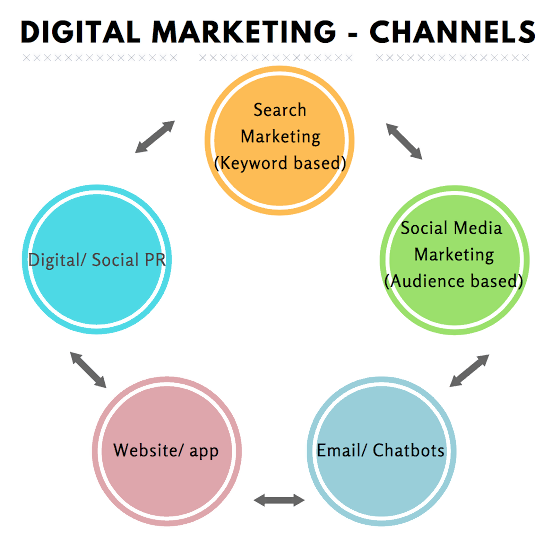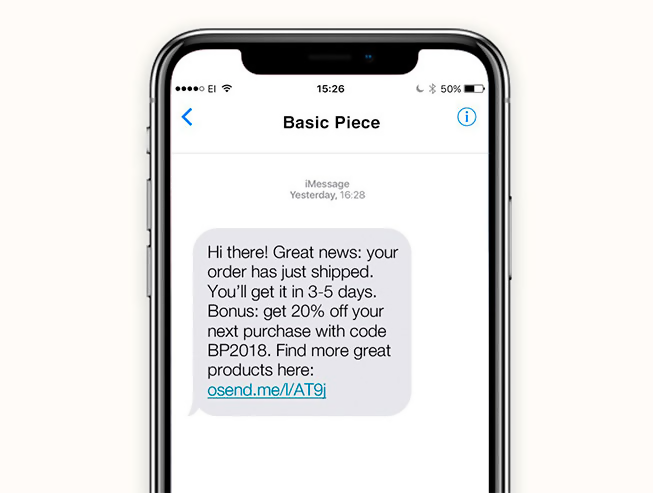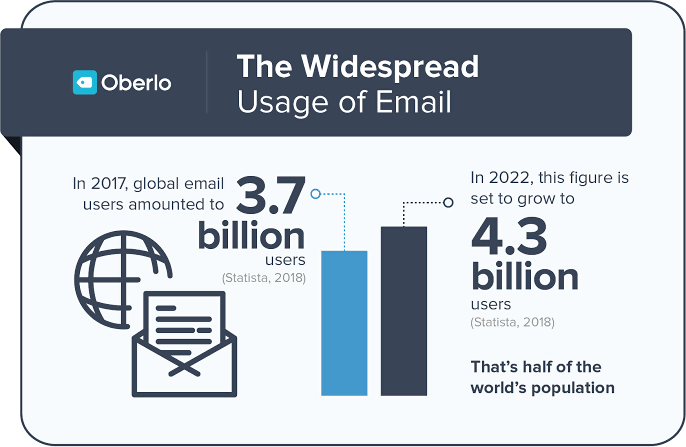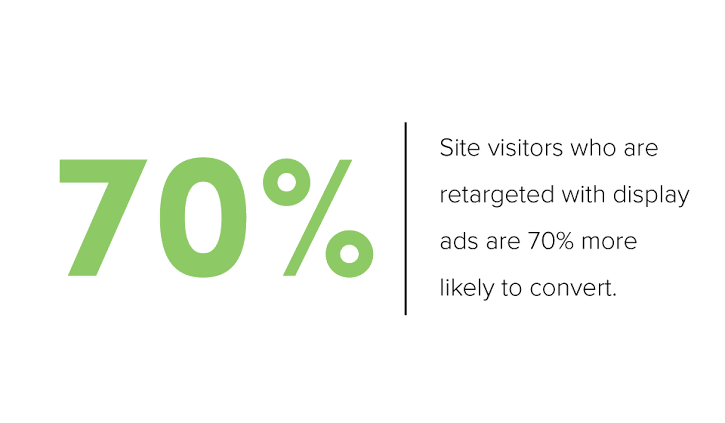When you start a project, do you delve right into it or plan before you execute it? Your marketing strategy is basically your planning phase.
It’s the building block of your business, and without it, your marketing efforts may just fall apart. However, it takes the entire team to get together and come up with the best possible strategy.
Luckily, I’ve done the job for you. I’ve listed down the most popular digital marketing channels and I’ll explain which one is best suited to your business.
Simultaneously, you can check out the current marketing trends that you should be incorporating into your marketing strategy:
Types of marketing channels

Ultimately, you should be using more than one marketing channel for your business because chances are, your consumer base has a number of different characteristics which is why they are segmented and each segment is active on various channels.
#1. Social media
Within social media, there’s a number of platforms we can break it down to – Twitter, Pinterest, Linkedln, Facebook and Instagram being some of the top communication channels.
Here is a detailed overview of which platform you should use based on your target audience:
Instagram is a hit with millennials. If you’re targetting the age group 18-35, then it’s perfect for your strategy.
Plus, it’s great for brand awareness. It’s a social media platform with the strongest power of hashtags, which makes it easier for you to make your brand visible – so that customers can find you easily and you can promote your brand through creative content that makes you go viral.
Moreover, it makes use of photo and video content only, which is great because videos are by far the most engaging content online.
In a HubSpot 2018 survey, 58% of consumers stated that they want to see more video content from their favourite brands:

You’d think Facebook was dying down especially after its privacy violation breach, but you’d be surprised to know that the platform is still peaking.
Facebook still holds the number 1 position for being the biggest social media site with 2.23 billion users.
However, you’ll only want to use it if your brand is targetted towards the age group 35 and above. Selling lifetime insurance? Create a Facebook ad. Selling massage chairs? Facebook is your go-to.
Not only that, but Facebook is a great way for personally interacting with your customers.
Similar to a website blog, you can create a Facebook group through which you can interact with your most loyal followers and give them expert advice about your brand and products.
This works great in the food industry as chefs and restaurant owners share their most trusted recipes, discounts and updates with their customers through private groups.
Here’s a platform with an extremely narrow user base. LinkedIn is perfect for you only if you’re targetting educated, intellectual individuals of all ages above 18 (but mostly millennials).
You’ll only need LinkedIn if you want to communicate with your target audience for professional purposes e.g. if you want to rent out office space or you’re selling office supplies.
But more than that, LinkedIn is great for lead generation and networking. With a LinkedIn profile, you can make contacts with some of the biggest names in the industry (and supporting industries) which will help you in the long run.

You can guest blog and create backlinks to high authority websites and do much more that can improve your SEO.
Plus, you can generate leads because with LinkedIn, you can see who is viewing your profile and that essentially are interested customers. Use this to contact them individually and sway them towards your brand.
With Pinterest, you’ll want a slightly different approach to marketing.
Here, you can target any market segment, but you’re not doing it for the purpose of selling anything to them. Pinterest is simply a platform for engaging with your customers and inspiring them with creative boards.
However, 80% of Pinterest’s target audience consists of women. This means that it’s great for women fashion brands, accessories, jewellery and everything that caters to women only.
Moreover, you’ll be able to enhance your brand image and expand your reach with Pinterest because 80% of pins are repins, which means your followers will share your content as long as it’s good!

#2. SMS
Another great marketing channel is SMS. Unfortunately, it’s not talked about too much. Despite having the highest open rate of 98%, SMS is still one of the most underutilised marketing channels.
SMS is great for one-on-one interaction with your customers. You can use it for the following purposes:
- Customer service
- Updates and offers
- Notifications
- Reminders
- Emergency alerts
- Tracking orders

Platforms like ExpressText will allow you to send out bulk text messages to all your customers. If you want to make your texts more engaging with the use of visuals, you can always opt for ProTexting which allows for MMS messages.
#3. Email
Did you know that 81% of businesses still rely on email as their primary market channel?

Platforms like MailChimp are great for sending out personalised emails to your customers, integrating email with other apps and built-in analytics to monitor the performance of your campaign.
Email marketing campaigns are great for increasing the reach of your blog content. Send your followers and potential customers creative and informational content related to your brand.
If you sell smartphones, send your followers tips about improving battery life or the 10 best smartphones under $300.
You don’t necessarily have to market your brand directly; just educating your customers about related topics will be enough to create brand awareness and online visibility.
The best tips for your marketing strategy
#1. Incorporate the newest marketing channels into your strategy
I talked about social media, email and SMS – but those have been around for a while now. There’s one thing I left till the end, and that’s voice interaction.
Voice searches have been going up ever since voice assistants like Google Home, Alexa and Bixby came around. If you think about it, it’s easier to speak to your phone rather than holding it up and typing a search in it.
Voice interactions come with their limitations i.e. a fewer search results due to limited screen space.
However, voice interactions have come a long way. Back when Siri was first introduced, it could only understand the American accent. However, voice interactions have become much smoother and technology advanced now.
Platforms like Jetson AI will also help you to integrate different voice assistants with your marketing platforms so that consumers can interact with your brand using voice interaction and searches.
#2. Use retargeting to create more conversions
Retargeting is one of the most important and effective marketing strategies that you can use.

If a potential customer views your product or abandons their cart without completing their purchase, you can use retargeting ads to get them to convert.
You can run these ads on social media platforms like Facebook and Instagram, or better yet, the next website that your consumer visits.
Shopaholics like me will definitely be tempted to complete their purchase, thus improving your conversion rate.
#3. Make use of videos & live videos
Like I mentioned earlier on in this article, videos are dominating the percentage of engaging content. You can use them for a number of purposes:
- Introducing a product, service or brand
- Product tutorials (how to assemble or use a product)
- Maintaining products and services (making the most out of them)
- Educating your followers about a topic (as an alternative to text blogs)
- Telling stories that are imprinted on consumer minds
Then there is the entirely new concept centred around live videos. You can make use of live videos through social media channels like Facebook and Instagram.
But how are they better than normal videos? Well, live videos are much more interactive. They allow for two way communication between followers and brands, which is much more engaging than commenting on a normal video.

Plus, using influencers can boost your marketing strategy because customers love nothing more than a real-life interaction with personalities that they look up to.
#4. Don’t underestimate user-generated content
User-generated content is one of the most powerful marketing tools out there that you can use without having to put in the effort yourself:

User-generated content is great because it creates trust between your brand and potential customers. You can post it through product reviews, feedback videos, customer experiences, posts etc.
#5. Optimize your online presence for search engines
All your marketing efforts will only be effective if your website is visible to potential customers online. Here a few SEO tips you can incorporate into your existing strategy:

There are two ways you can improve your SEO paid and organic. Google ads will allow you to rank your website at the top of the search page. With every click that your website receives, you’ll pay a certain amount to Google. Here’s how your ad will show with Google AdWords:
Organically, there are a number of ways that you can improve your SEO:
- Reduce your website’s loading time
- Update your website to create a good appearance
- Use relevant keywords for your blog
- Use clear meta titles and descriptions
- Create backlinks to high authority websites
- Fix any broken backlinks
- Optimise your site for mobile
- Publish quality content on your blog
- Create a strong internal link structure
The advantage of organically improving your SEO is that you won’t have to bear any promotion costs since your website will be ranked based on its compliance with Google’s guidelines for SEO.
However, it’s a lot of work and you’ll need to invest your time and energy into optimising your website. You’ll need a good web designer and creative writers to spruce up your blog and improve reach.
You can use tools like Google Keyword Planner to find the most relevant keywords for your site.
To monitor the performance of your SEO campaign, check out 29 free SEO tools that you can use to improvise your strategy.
#6. Use the right analytical tools
The last and most important step of executing your marketing strategy is to analyse its performance. By knowing where you’re doing well and what your weak points are, you’ll be able to improvise your strategy accordingly.
However, this is an area that you’ll have to invest your resources in. You can find free analytical tools like Google Analytics which are great for perceiving consumer insight, but they won’t provide you with an in-depth insight that paid platforms can.
You’ll need to analyse all aspects of your strategy – including SEO, upselling, down selling, conversions, lead generations etc. so that you can improve your strategy accordingly.
Check out the Top 10 smartest web analytical tools for your business.
Conclusion
So that’s the best marketing strategy that you can aim for. By following all the current marketing trends and investing in the right places, you can maximise profitability in the long run.
